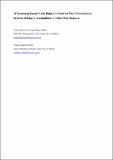Files in this item
‘If something doesn’t look right, go find out why’ : how intuitive decision making is accomplished in police first-response
Item metadata
| dc.contributor.author | Akinci, Cinla | |
| dc.contributor.author | Sadler-Smith, Eugene | |
| dc.date.accessioned | 2020-12-07T15:54:24Z | |
| dc.date.available | 2020-12-07T15:54:24Z | |
| dc.date.issued | 2020-01-02 | |
| dc.identifier | 261907639 | |
| dc.identifier | 03eb6daf-9a1b-47fa-bc0e-29237f758608 | |
| dc.identifier | 85075428371 | |
| dc.identifier | 000498277800001 | |
| dc.identifier.citation | Akinci , C & Sadler-Smith , E 2020 , ' ‘If something doesn’t look right, go find out why’ : how intuitive decision making is accomplished in police first-response ' , European Journal of Work and Organizational Psychology , vol. 29 , no. 1 , pp. 78-92 . https://doi.org/10.1080/1359432X.2019.1681402 | en |
| dc.identifier.issn | 1359-432X | |
| dc.identifier.other | ORCID: /0000-0001-9053-3967/work/77524812 | |
| dc.identifier.uri | https://hdl.handle.net/10023/21069 | |
| dc.description.abstract | Intuition is an important mechanism by which organizational actors make significant decisions; however, precisely how intuitive decisions are taken is not well understood and hence is worthy of closer scrutiny. First-response decisions, because of the conditions under which they are executed, offer researchers an interesting and relevant context for the study of intuitive decision making in organizations. We used qualitative methods to explore how “peak performing” police officers used intuition in first-response decisions. Our findings show that intuition’s role in first-response occurs in two differing but complementary ways: “recognition-based intuition” and “intuition-based inquiry”. This finding builds on previous intuition research and informs current debates in behavioural sciences regarding “default-intervention” versus “parallel-competitive” variants of dual-process theory; it also reveals how a complex and situated mix of intuition and analysis can guide effective decision making and support peak performance in uncertain, dynamic and complex environments that typify many organizational decision processes. Our findings contribute to intuition research by extending the current theory of “intuition-as-expertise” in going beyond a simple “recognize-and-respond” model. We propose a “Perceiving-Knowing-Enacting-Closing” framework which captures the complex role that intuition in combination with analysis plays in police first-response decisions, and discuss implications for decision-making policies and practices in organizations. | |
| dc.format.extent | 589863 | |
| dc.language.iso | eng | |
| dc.relation.ispartof | European Journal of Work and Organizational Psychology | en |
| dc.subject | Decision making | en |
| dc.subject | Dual-process | en |
| dc.subject | Intuition | en |
| dc.subject | Police first-response | en |
| dc.subject | H Social Sciences (General) | en |
| dc.subject | HD28 Management. Industrial Management | en |
| dc.subject | NDAS | en |
| dc.subject | BDC | en |
| dc.subject | R2C | en |
| dc.subject.lcc | H1 | en |
| dc.subject.lcc | HD28 | en |
| dc.title | ‘If something doesn’t look right, go find out why’ : how intuitive decision making is accomplished in police first-response | en |
| dc.type | Journal article | en |
| dc.contributor.institution | University of St Andrews. School of Management | en |
| dc.identifier.doi | https://doi.org/10.1080/1359432X.2019.1681402 | |
| dc.description.status | Peer reviewed | en |
| dc.date.embargoedUntil | 2020-11-24 |
This item appears in the following Collection(s)
Items in the St Andrews Research Repository are protected by copyright, with all rights reserved, unless otherwise indicated.

